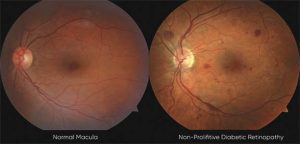Dr. Katia Taba, Board-Certified Ophthalmologist and Retinal Specialist


The Two Stages of Diabetic Eye Disease
There are two main stages of diabetic eye disease.
NPDR (non-proliferative diabetic retinopathy)
This is the early stage of diabetic eye disease. Many people with diabetes have it.
With NPDR, tiny blood vessels leak, making the retina swell. When the macula swells, it is called diabetic macular edema (DME). This is the most common reason why people with diabetes lose their vision. DME can be present or not with NPDR or PDR.
Also, with NPDR, blood vessels in the retina can close off. This is called macular ischemia. When that happens, blood cannot reach the macula. Sometimes tiny particles called exudates can form in the retina. These can affect your vision too.
The changes from NPDR can happen without you noticing any change to your vision. That is why diabetics need to have an annual screening for diabetic retinopathy.
PDR (proliferative diabetic retinopathy)
PDR is the more advanced stage of diabetic eye disease. It happens when the retina starts growing new blood vessels. This is called neovascularization. These fragile new vessels often bleed into the vitreous. If they only bleed a little, you might see a few dark floaters. If they bleed a lot, it might block all vision.
These new blood vessels can form scar tissue. Scar tissue can cause problems with the macula or lead to a detached retina causing a tractional retinal detachment (TRD) which sometimes is irreversible visual loss.
PDR is very serious, and can steal both your central and peripheral (side) vision. Just like NPDR, your eye can silently develop PDR. And again, that is why it is so important to screen for diabetic retinopathy.
What Happens When You Have Diabetic Retinopathy?
You can have diabetic retinopathy and not know it. This is because it often has no symptoms in its early stages. As diabetic retinopathy gets worse, you will notice symptoms such as:
• seeing an increasing number of floaters
• having blurry vision
• having vision that changes sometimes from blurry
to clear
• seeing blank or dark areas in your field of vision
• having poor night vision
• noticing colors appear faded or washed out
• losing vision.
Diabetic retinopathy symptoms usually affect both eyes.
Diabetic Retinopathy Diagnosis
Drops will be put in your eye to dilate (widen) your pupil. This allows your ophthalmologist to look through a special lens to see the inside of your eye.
Your doctor may do optical coherence tomography (OCT) to look closely at the retina. A machine scans the retina and provides detailed images of its thickness. This helps your doctor find and measure swelling of your macula.
Fluorescein angiography and OCT angiography help your doctor see what is happening with the blood vessels in your retina. Fluorescein angiography uses a yellow dye called fluorescein, which is injected into a vein (usually in your arm). The dye travels through your blood vessels. A special camera takes photos of the retina as the dye travels throughout its blood vessels. This shows if any blood vessels are blocked or leaking fluid. It also shows if any abnormal blood vessels are growing.
Can Diabetic Retinopathy Go Away?
Your treatment is based on what your ophthalmologist sees in your eyes. Treatment options may include:
Medical control
Controlling your blood sugar and blood pressure can stop vision loss. Carefully follow the diet your nutritionist has recommended. Take the medicine your diabetes doctor prescribed for you. Sometimes good sugar control alone can bring some of your vision back. Controlling your blood pressure keeps your eye blood vessels healthy.
Drug treatment
One type of medication is called anti-VEGF medication. These include Avastin, Eylea, Lucentis and the newly FDA-approved Vabysmo. Anti-VEGF medication helps to reduce swelling of the macula, regress diabetic retinopathy, slowing vision loss and improving vision. This drug is given by injections (shots) in the eye. Steroid medicine is another option to reduce macular swelling from DME. This can also be given as injections in the eye. Your doctor will recommend how many medication injections you will need over time.
Laser surgery
Laser surgery can be used to help seal off leaking blood vessels. This can reduce swelling of the retina. Laser surgery can also shrink abnormal blood vessels and prevent them from growing again. Often more than one treatment is needed.
Vitrectomy
If you have advanced PDR, your ophthalmologist may recommend a surgery called vitrectomy. Your ophthalmologist removes vitreous gel and blood from leaking vessels in the back of your eye. This allows light rays to focus properly on the retina again. Scar tissue also might be removed from the retina.
5 Ways to Prevent Vision Loss from Diabetic Retinopathy
• If you have diabetes, talk with your primary care doctor about controlling your blood sugar. High blood sugar damages retinal blood vessels. This causes vision loss.
• Do you have high blood pressure or kidney problems? Ask your doctor about ways to manage and treat these problems.
• See your ophthalmologist regularly for dilated eye exams. Diabetic retinopathy may be found before you even notice any vision problems.
• If you notice vision changes in one or both eyes, call your ophthalmologist right away.
• Get treatment for diabetic retinopathy as soon as possible. This is the best way to prevent vision loss.
Do You Have Diabetes and Need an Eyeglasses Exam?
Changes in blood sugar levels can affect your vision. Make sure your blood sugar is under control for at least a week before an eye exam. Eyeglasses prescribed when your blood sugar levels are stable work best! The best is to have an eye exam prior to getting glasses. Eye exams are part of your medical insurance and separate from the vision plan for glasses offered by certain health insurance plans.
Personalized Retina Care of Naples
If you are experiencing any changes in your eye health, whether it is blurry vision, pain, impaired vision, or any other visual irregularities, you should see an ophthalmologist right away. The earlier a disease is detected, the better the outcome and treatment options are for you. You will find a friendly and warm environment at Personalized Retina Care of Naples.
Please call (239) 325-3970 today to schedule your eye exam. When necessary same day appointments can often be accommodated.
Personalized Retina Care of Naples provides comprehensive diagnosis and treatment for retinal disorders. Dr. Taba also gives second opinions on retinal and general eye conditions. Dr. Taba is a Board-Certified Ophthalmologist and is Fellowship trained in surgical and medical retinal diseases.
www.retinanaples.com | 239-325-3970
3467 Pine Ridge Rd., Suite 103, Naples 34109
Source:
https://www.aao.org/eye-health/diseases/what-is-diabetic-retinopathy
 Southwest Florida's Health and Wellness Magazine Health and Wellness Articles
Southwest Florida's Health and Wellness Magazine Health and Wellness Articles

